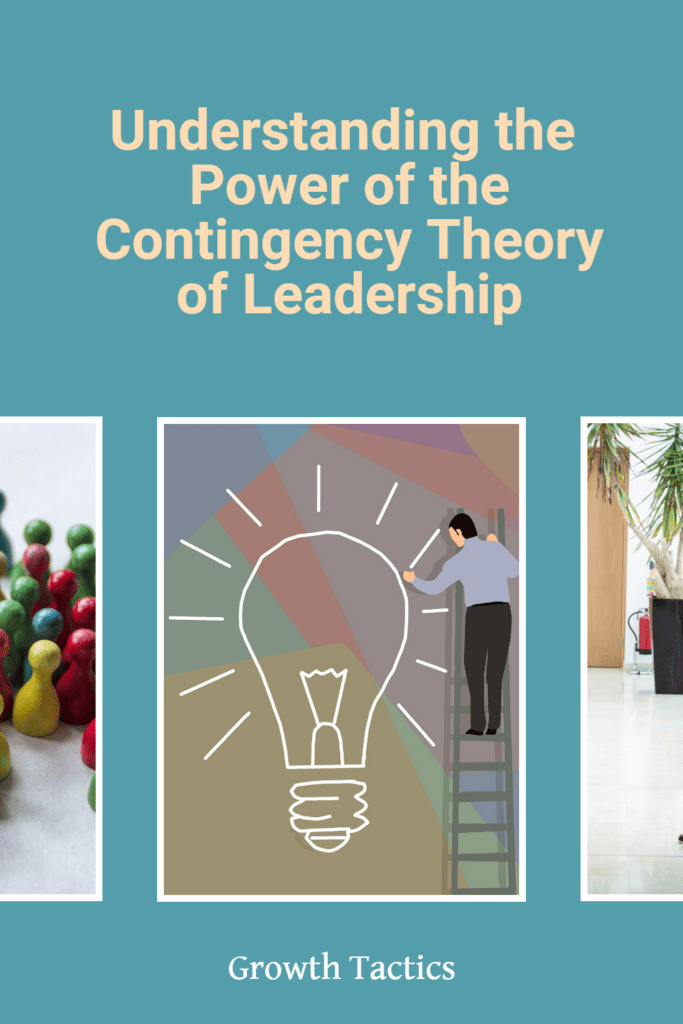As a leader, it’s crucial to adopt the right leadership style to ensure your team’s success. However, with so many different leadership theories and styles to consider, finding the right approach can be challenging. This is where the contingency theory of leadership comes in.
Jump To Section
What is the Contingency Theory of Leadership?
The contingency theory of leadership, also known as the situational contingency theory, is a leadership theory that proposes that the effectiveness of a leader is contingent on the situation and the environment they find themselves in. In other words, there is no one-size-fits-all approach to leadership; leaders must adapt their leadership style to the current situation to be effective.
One of the key figures in developing the contingency theory of leadership is Fred Fiedler. Fiedler’s contingency model states that a leader’s effectiveness depends on two factors: their leadership style and the situational favorableness of the situation. Situational favorableness refers to the extent to which the situation allows the leader to exert influence over their team.
Understanding the Contingency Theory of Leadership
To apply the contingency theory of leadership effectively, it’s essential to understand the different contingency theories and models of leadership. There are various contingency theories, such as the path-goal theory, the vroom-yetton contingency model, and the normative decision theory. Each of these theories focuses on a different aspect of leadership and determines the relationship between leadership style and effectiveness.
Fiedler’s contingency theory is perhaps the most well-known of all the contingency theories. Fiedler’s theory proposes that there are three types of leaders: relationship-oriented leaders, task-oriented leaders, and those who fall in between. The theory states that leadership styles can be determined by the leader’s natural leadership style, the situation they find themselves in, and the leader’s perception of their own power and influence.
More Examples of the Contingency Leadership Theory
In our previous sections, we explored the ins and outs of the contingency leadership theory and covered its basic principles. Now, let’s take a closer look at some practical examples of how this theory can be applied in various real-life scenarios. By examining these examples, you’ll gain a deeper understanding of how the contingency leadership theory can truly make a difference in different industries and contexts.
Example 1: Leadership in the Healthcare Industry
In the fast-paced and ever-evolving world of healthcare, the contingency leadership theory is like a guiding light for effective leadership. Consider a hospital setting, where doctors, nurses, and support staff work together to provide top-notch care. The theory suggests that a leader should adapt their leadership style based on the unique circumstances they face.
For instance, a contingency leader in healthcare would recognize that in emergency situations, such as a medical crisis, a more directive and hands-on approach may be necessary to ensure swift decision-making and coordinated actions. On the other hand, in non-emergency situations, a more participative and empowering approach could be beneficial, as it allows healthcare professionals to share their expertise and ideas.
Example 2: Leadership in Technology Startups
In the dynamic and rapidly changing world of technology startups, the contingency leadership theory is like a secret weapon for success. Imagine a startup that’s developing cutting-edge software. The theory suggests that a leader should assess the situation and adjust their leadership style accordingly.
Let’s say the startup is in the early stages of development, and the team consists of highly skilled and motivated software engineers. In this case, a contingency leader would adopt a more hands-off approach, providing the necessary resources and support while allowing the engineers to take ownership and drive the creative process. As the startup grows and faces new challenges, the leader might need to step in and provide more guidance or support to ensure continued success.
Example 3: Leadership in Education
Education is another domain where the contingency leadership theory can work wonders. Whether you’re the principal of a school or a teacher leading a classroom, understanding the unique circumstances and adapting your leadership style can greatly impact student learning outcomes.
In a school setting, a contingency leader would consider factors such as the size of the school, the resources available, and the needs of the students and staff. For instance, in a school with a large teaching staff and experienced educators, a more delegative leadership style might be suitable, allowing teachers the autonomy to implement innovative teaching methods. On the other hand, in a school with inexperienced teachers, a more directive approach that provides clear guidance and support may be necessary.
Example 4: Leadership in Manufacturing
The manufacturing industry presents yet another arena where the contingency leadership theory proves its worth. In a manufacturing plant that operates on a large scale with diverse teams and complex production processes, effective leadership is crucial for success.
A contingency leader in manufacturing would assess the situation and adjust their leadership style accordingly. For instance, in a fast-paced production line where efficiency and productivity are paramount, a more directive leadership style might be needed to ensure smooth operations. However, in a research and development department focused on innovation and experimentation, a more participative leadership style could foster creativity and collaboration.
Applying Contingency Theory
Now that we understand the fundamental idea behind contingency theory, let’s see how it can be applied in the workplace. Picture this: you’re the leader of a team facing a complex project with tight deadlines. Each team member has varying levels of expertise, and the project requirements are evolving constantly. So, how can you apply contingency theory to navigate this challenge and lead your team to success?
Assess the Situation
The first step in applying contingency theory is to assess the situation at hand. Consider the factors involved, such as the project’s complexity, the skill set of your team members, and the resources available. By understanding the unique circumstances, you can determine the most effective leadership approach for the task.
Tailor Your Leadership Style
Once you’ve assessed the situation, it’s time to adapt your leadership style accordingly. Contingency theory emphasizes that different situations call for different approaches. For example, if your team members possess a high level of expertise and are self-motivated, you might adopt a more hands-off, delegative leadership style. On the other hand, if the project requires close guidance and supervision, a more directive approach may be necessary.
Flexibility is Key
As a leader applying contingency theory, flexibility is your secret weapon. The ability to adjust your leadership style on the fly demonstrates your versatility and adaptability. Let’s say there’s a sudden change in the project scope. Instead of rigidly sticking to your initial plan, you embrace the unexpected and pivot your approach to align with the new circumstances. This flexibility allows you to navigate the unpredictable and keep your team on track.
Continuously Monitor and Adjust
Remember, contingency theory isn’t a one-time decision-making process. It’s an ongoing and dynamic approach. As circumstances change, you must continuously monitor the situation and be ready to adjust your leadership style accordingly. Regularly check in with your team, gather feedback, and stay attuned to any shifting dynamics. This constant evaluation and adaptation will ensure you remain effective in your leadership role.
Comparing the Contingency Leadership Model to Other Models
When it comes to leadership, there’s no shortage of theories and models out there. Each one brings its own unique perspective to the table, aiming to guide leaders in making effective decisions. In this section, we’ll take a closer look at the contingency leadership model and compare it with some other prominent models in the field. So, let’s dive in and explore the similarities, differences, and strengths of these approaches.
The Contingency Leadership Model: Embracing Flexibility
The contingency leadership model, as we’ve discussed before, emphasizes the importance of adapting leadership styles to fit the unique circumstances of a situation. It recognizes that there’s no one-size-fits-all approach to leadership and encourages leaders to be flexible and responsive. The model suggests that the most effective leadership style depends on factors such as the task at hand, the team’s capabilities, and the overall organizational context.
Situational Leadership Model: Matching Leadership Styles to Development Levels
The Situational Leadership Model, developed by Paul Hersey and Ken Blanchard, takes a similar approach to the contingency leadership model. It proposes that effective leaders should adjust their leadership style based on the development level of their followers. The model identifies four leadership styles, ranging from directing to delegating, and suggests matching these styles to the readiness and capability of the individuals being led. In essence, leaders should provide the right level of guidance and support depending on the follower’s competence and commitment.
Transformational Leadership Model: Inspiring and Motivating Change
The Transformational Leadership Model, popularized by James MacGregor Burns, focuses on a leader’s ability to inspire and motivate followers to achieve extraordinary results. It emphasizes the importance of charisma, vision, and emotional intelligence. Transformational leaders are skilled at articulating a compelling vision, empowering and developing their followers, and fostering a sense of trust and commitment. While not explicitly contingent on specific situations, transformational leaders can still adapt their style to different contexts.
Servant Leadership Model: Putting Others First
The Servant Leadership Model, championed by Robert K. Greenleaf, flips the traditional leadership approach upside down. It places the leader in a role of service, prioritizing the needs of others above their own. Servant leaders focus on empathy, listening, and nurturing the personal growth and well-being of their team members. While the model doesn’t explicitly address contingency, leaders can incorporate flexibility and adaptability into their servant leadership style, tailoring their selfless approach to different circumstances.
Common Threads and Unique Perspectives
Though these leadership models take different angles, they all contribute valuable insights to the field. The contingency leadership model, situational leadership model, transformational leadership model, and servant leadership model share a common thread of recognizing the importance of adaptability and tailoring one’s leadership style. Each model presents different nuances and emphases that leaders can draw from based on their specific needs and situations.
In the end, successful leaders aren’t limited to adhering strictly to one single model. Instead, they have the knowledge and flexibility to incorporate elements from multiple models, depending on the complexities of their environment and the needs of their team. So, don’t be afraid to mix and match, pulling inspiration and guidance from various frameworks to create your unique leadership style.
Remember, being an effective leader is about understanding the power of flexibility, empathy, inspiration, and service. By embracing the principles of the contingency leadership model and supplementing them with valuable insights from other models, you’ll be well-equipped to navigate the ever-changing landscape of leadership and lead your team to new heights.
Conclusion
The contingency theory of leadership is a valuable approach that emphasizes the importance of adapting your leadership style to the situation you find yourself in. By understanding the different contingency theories and models of leadership, you can improve your leadership skills and become a more effective leader. So, take the time to learn about the contingency theory and apply it to your leadership approach. Your team will thank you for it!


